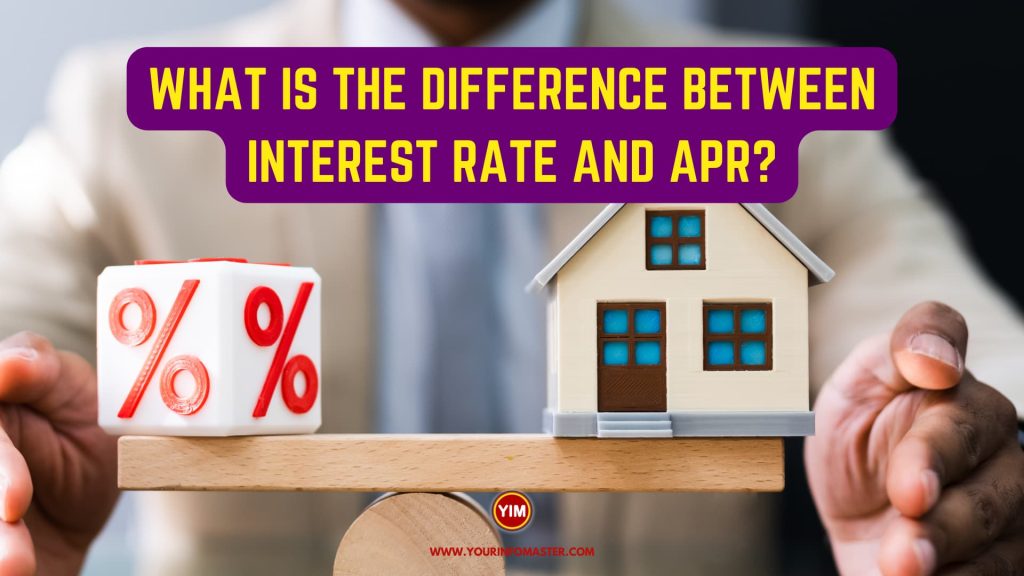I am going to explain the blog post “What is the difference between interest rate and APR?“
Are you confused about the terms “interest rate” and “APR”? If so, you’re not alone. Many people often use these terms interchangeably, assuming they mean the same thing. However, there are crucial distinctions between interest rates and APR that can significantly impact your financial decisions.
In this blog post, we will unravel the differences between interest rates and APR, shedding light on their unique roles in the world of finance.
Check also: What is the difference between Microeconomics and Macroeconomics?
5 Differences between interest rate and APR
To help you gain a better understanding, here is a list of the five key differences between interest rates and APR. By comprehending these distinctions, you can make informed choices when it comes to loans, mortgages, credit cards, and other financial products.
Here is a list of 5 differences between interest rate and APR:
- Definition and Scope
- Inclusion of Additional Costs
- Comparison of Loan Options
- Impact on Monthly Payments
- Evaluating the True Cost
Check also: What is the difference between Juneteenth and independence day?
Detail of 5 Differences between interest rate and APR
Here is the detail of 5 differences between interest rate and APR:
Definition and Scope
The first difference between interest rates and APR lies in their definitions and scope. The interest rate refers to the percentage charged by a lender for borrowing money. It represents the cost of borrowing and is typically expressed on an annual basis. On the other hand, APR, which stands for Annual Percentage Rate, encompasses the interest rate along with additional costs associated with the loan. These additional costs may include origination fees, closing costs, and other charges. While interest rates focus solely on borrowing costs, APR provides a more comprehensive view by considering both the interest rate and other fees involved.
Inclusion of Additional Costs
One of the key distinctions between interest rate and APR is the inclusion of additional costs in the APR. As mentioned earlier, interest rates only reflect the cost of borrowing money. In contrast, APR incorporates various fees and charges associated with the loan, such as application fees, underwriting fees, and points paid to lenders. By including these additional costs, the APR provides a more accurate representation of the total borrowing cost, giving borrowers a clearer picture of the overall expense involved in obtaining the loan.
Comparison of Loan Options
When comparing different loan options, the interest rate and APR play different roles. Interest rates are primarily used to compare the cost of borrowing between lenders or financial institutions. A lower interest rate means a lower cost of borrowing. However, APR is more useful when comparing loans with different terms and fee structures. Since APR includes additional costs, it allows borrowers to assess the total cost of loans more comprehensively. Comparing APRs enables borrowers to make more informed decisions by considering both the interest rate and other associated fees.
Impact on Monthly Payments
Interest rates and APR can have different effects on monthly payments. The interest rate directly affects the amount of interest paid each month. Higher interest rates result in higher monthly interest payments. However, APR influences the overall loan cost, which indirectly impacts the monthly payments. If two loans have the same interest rate but different APRs, the loan with the higher APR will typically have higher monthly payments due to the inclusion of additional costs in the APR calculation. Therefore, borrowers need to consider both the interest rate and APR to understand how they will affect their monthly budget.
Evaluating the True Cost
The final difference between interest rates and APR is their ability to evaluate the true cost of borrowing. While interest rates provide a straightforward representation of the borrowing cost, APR offers a more comprehensive assessment. By factoring in additional fees and charges, APR reflects the total cost of borrowing over the loan’s term. This is particularly important for long-term loans, such as mortgages, where additional costs can significantly impact the overall expense. Therefore, when evaluating loan options, borrowers should consider both the interest rate and APR to gain a more accurate understanding of the true cost and make informed decisions based on their financial goals.
Conclusion
Understanding the differences between interest rates and APR is crucial for making sound financial decisions. While interest rates reflect the cost of borrowing money, APR takes into account additional fees and charges.
By considering both factors, you can accurately assess the true cost of a loan or credit card. Remember that interest rates are essential for short-term comparisons, while APR provides a comprehensive picture of long-term borrowing costs.
By educating yourself on these distinctions, you can navigate the world of finance more effectively and make informed decisions that align with your financial goals.
See also: What is the difference between family medicine and internal medicine?
If you really enjoyed the article “What is the difference between interest rate and APR?,” then I would be very grateful if you’d help it spread by emailing it to your friends or sharing it on Twitter, Instagram, or Facebook. Thank you!
Have you read “What is the difference between interest rate and APR?“ Which of these blogs are you reading, and how is it similar to one of them?

